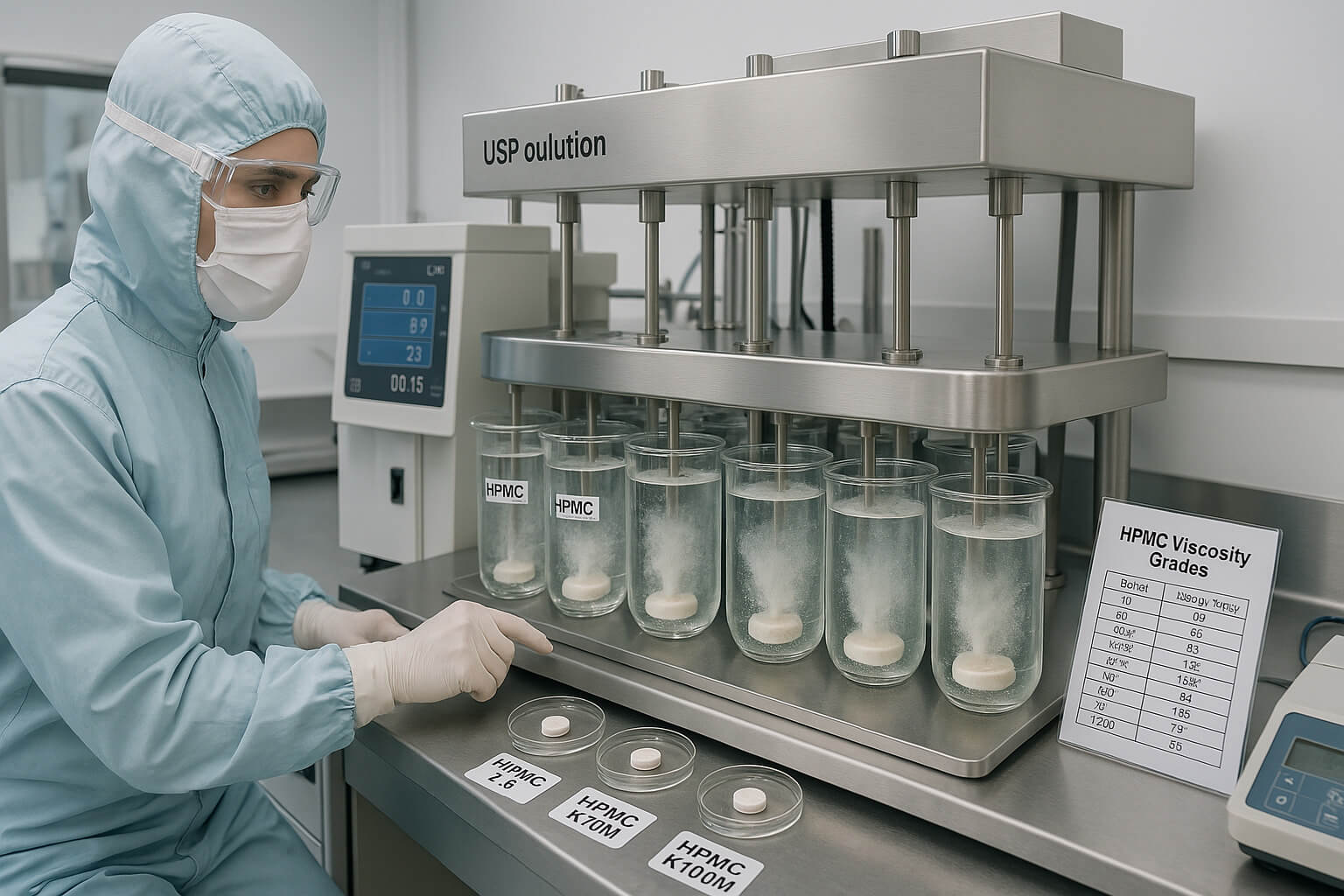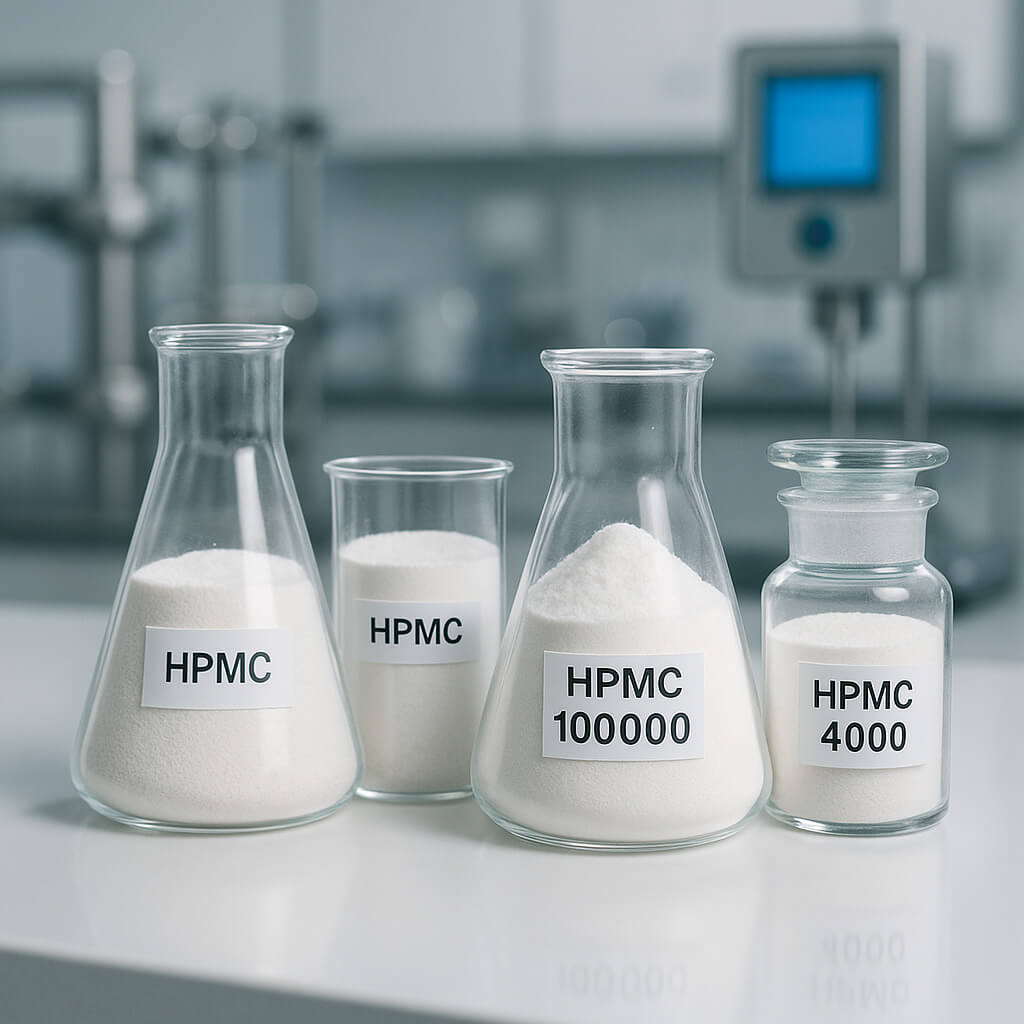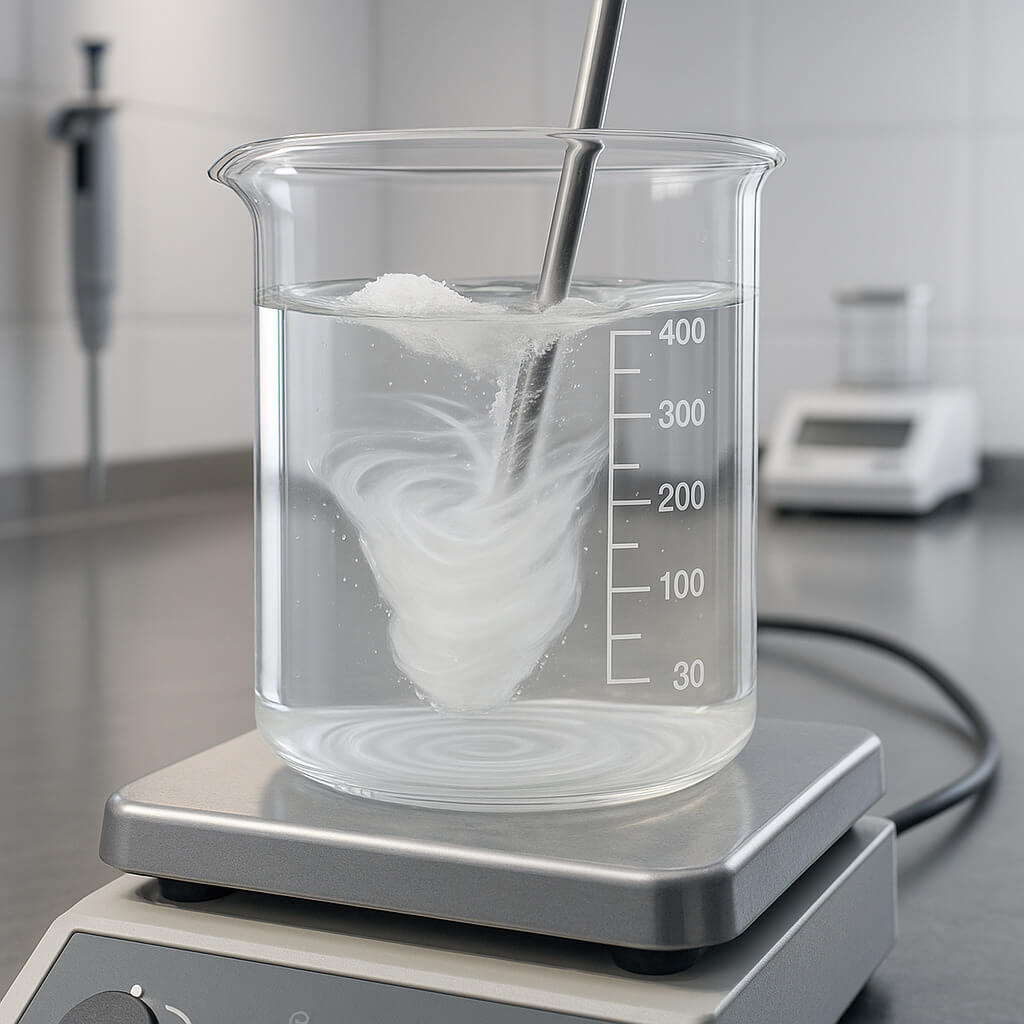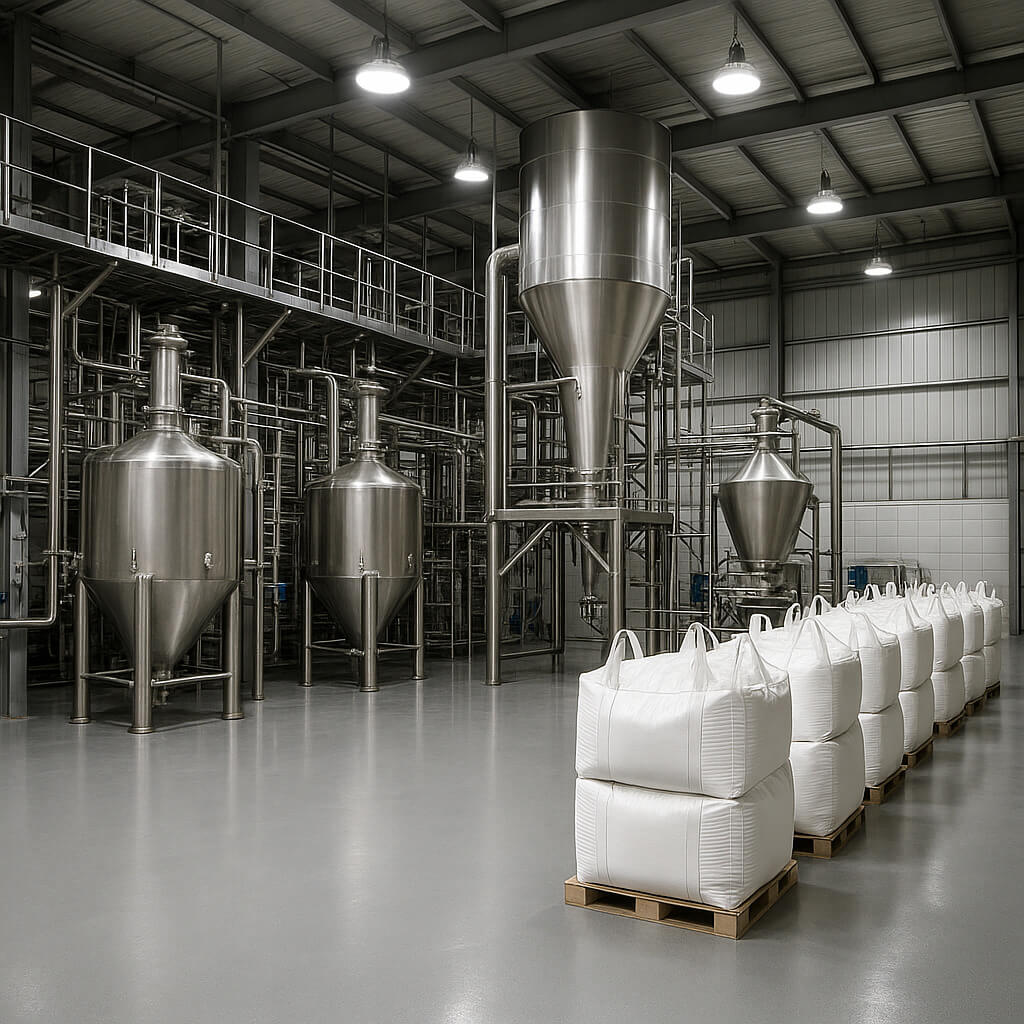Formulating tablets with inconsistent HPMC viscosity can lead to unpredictable drug release profiles and compromised product quality, putting both regulatory compliance and patient safety at risk.
HPMC viscosity directly impacts critical tablet properties including drug release rate, mechanical strength, and overall performance. The right viscosity grade ensures controlled dissolution, proper binding, and optimal drug delivery while maintaining tablet integrity throughout its shelf life.

Laboratory technician testing different HPMC viscosity grades for tablet formulation, showing dissolution test apparatus with various tablet samples in different release stages.
Understanding HPMC viscosity parameters helps formulators develop robust tablet formulations that meet strict regulatory requirements. Let’s examine how viscosity influences various aspects of pharmaceutical tablet development and what factors to consider when selecting the optimal grade for specific applications.
What is the role of HPMC viscosity in pharmaceutical tablet manufacturing?
Inconsistent viscosity in hydrophilic matrix systems can disrupt manufacturing processes, causing batch failures and resulting in significant production delays and material waste.
HPMC viscosity serves as a critical quality attribute that determines how effectively the polymer functions as a controlled-release matrix, binding agent, or film-coating component in tablet formulations. Higher viscosity grades create more robust gel layers that provide better control over drug release, while lower viscosity grades offer improved processing characteristics and faster hydration.
We’ve observed through our factory testing that HPMC viscosity directly correlates with gel formation speed and strength. When HPMC particles contact water during the dissolution process, they hydrate and form a protective gel layer around the tablet. This gel layer thickness and density, controlled by the HPMC’s viscosity grade, determines how quickly water penetrates and how slowly the drug diffuses out of the matrix.
The molecular weight of HPMC fundamentally determines its viscosity, ranging from approximately 10,000 to 1,500,000 Daltons depending on the grade. During our manufacturing process, we carefully control the degree of polymerization to achieve specific viscosity ranges suitable for various pharmaceutical applications. This molecular parameter affects not only the polymer’s ability to swell and form gels but also its compressibility and flowability during tablet production.
How does HPMC viscosity influence drug release and dissolution rates?
Failed dissolution tests from improper viscosity selection can force reformulation efforts, extending development timelines by months and potentially delaying market entry for critical medications.
HPMC viscosity directly controls the drug release mechanism by determining gel layer formation speed, thickness, and erosion rate. Higher viscosity grades create thicker, more robust gel barriers that slow drug diffusion, while lower viscosity grades form thinner gels that allow faster release profiles.
In our pharmaceutical-grade HPMC production facility, we regularly test how different viscosity grades affect dissolution patterns. The relationship between viscosity and drug release follows a predictable logarithmic correlation in most formulations. Through controlled dissolution testing, we’ve documented that doubling HPMC viscosity typically reduces the initial release rate by 25-30% for water-soluble compounds.
The viscosity of HPMC creates three distinct phases during tablet dissolution that dictate the overall release kinetics. First, when the tablet contacts dissolution media, HPMC particles on the surface immediately begin to hydrate. Second, as water continues to penetrate, the polymer chains within higher viscosity HPMC maintain greater entanglement density, creating more tortuous diffusion pathways. Finally, the erosion phase progresses more gradually with high-viscosity grades, extending the overall dissolution time beyond what lower viscosity alternatives can achieve.
For highly soluble drugs that tend to release too quickly, we’ve found that K4M, K15M, and K100M viscosity grades provide progressively stronger diffusion barriers. Through hundreds of formulation support projects, our technical team has mapped optimal viscosity ranges for common drugs based on their solubility characteristics.
What effects does HPMC viscosity have on tablet mechanical properties?
Tablets with improper viscosity-strength balance may crumble during packaging or transport, leading to product recalls and substantial financial losses for pharmaceutical companies.
HPMC viscosity significantly impacts tablet hardness, friability, and overall physical integrity. Higher viscosity grades typically produce stronger compacts with better resistance to mechanical stress during manufacturing, packaging, and transport.
Throughout our production quality testing, we consistently observe that HPMC’s viscosity correlates strongly with its binding capacity in direct compression formulations. When measuring tablet hardness across viscosity ranges, our laboratory has documented approximately 15-20% increases in crushing strength when moving from E5 to E50 viscosity grades at equivalent compression forces.
- Higher viscosity HPMC (K100M, K200M) provides superior tablet hardness but may require greater compression force
- Medium viscosity grades (K15M, K4M) offer balanced mechanical properties with good processing characteristics
- Lower viscosity options (E3, E5, E15) improve flow properties but may require additional binders for optimal hardness
- Particle size distribution within each viscosity grade affects both compressibility and the resulting tablet porosity
- Moisture content must be strictly controlled as it significantly impacts the binding efficiency of all HPMC grades
The relationship between HPMC viscosity and tablet disintegration presents important considerations for formulators. Through comparative studies in our application laboratory, we’ve found that higher viscosity grades form more cohesive matrices that resist mechanical breakdown even after prolonged exposure to dissolution media. This property can be advantageous for controlled-release formulations where maintaining structural integrity is essential for consistent drug delivery.
How does viscosity affect excipient performance in different formulation strategies?
Selecting incompatible viscosity grades for formulation strategies can trigger stability issues that only emerge during accelerated aging studies, potentially invalidating months of development work.
HPMC viscosity determines how effectively it functions alongside other excipients in complex formulations. The interaction between HPMC and other ingredients varies significantly based on viscosity grade, affecting everything from powder flow to drug release modification.
In our factory formulation support work, we’ve observed consistent patterns of excipient interaction across viscosity grades. Higher viscosity HPMC demonstrates stronger synergistic effects with anionic polymers like sodium alginate or carboxymethylcellulose, enhancing gel strength and prolonging release rates beyond what either polymer achieves independently.
When combined with soluble fillers like lactose or mannitol, HPMC viscosity directly influences the hydration rate and subsequent dissolution behavior. Through dissolution profile mapping across dozens of formulations, our laboratory has demonstrated that high-viscosity HPMC grades maintain more consistent release patterns in the presence of soluble fillers compared to lower viscosity alternatives.
The performance of HPMC in multi-component matrix systems depends heavily on its viscosity-derived swelling capacity. Our comparative studies with different viscosity grades reveal that K100M and K200M types can maintain functional gel barriers even when diluted to 20-30% of the total formulation weight. In contrast, lower viscosity grades like E5 or K4M may require 40-50% concentration to achieve comparable release control when working alongside non-swelling excipients.
HPMC viscosity also influences compatibility with processing aids and lubricants. Through extensive testing with pharmaceutical manufacturing equipment, we’ve found that higher viscosity grades typically require increased lubricant levels to prevent sticking and picking during compression.
How can formulators choose the right HPMC viscosity grade for specific applications?
Selecting the wrong viscosity grade can force complete reformulation efforts late in development, potentially delaying product approval timelines by 6-12 months for critical medications.
Choosing the optimal HPMC viscosity involves analyzing multiple factors including drug solubility, desired release profile, manufacturing method, and target product specifications. A systematic approach focusing on critical quality attributes helps narrow down the most suitable viscosity range.
| Viscosity Grade | Typical Applications | Dissolution Time | Processing Characteristics | Recommended Drug Solubility Range |
|---|---|---|---|---|
| E3, E5, E15 (3-15 mPa·s) | Immediate-release film coating, Binder in wet granulation | <30 minutes | Excellent flow, low compression force | >500 mg/mL |
| E50, K100 (50-100 mPa·s) | Binder in direct compression, Short-acting modified release | 1-4 hours | Good flow, moderate compression force | 100-500 mg/mL |
| K4M, K15M (4,000-15,000 mPa·s) | 8-12 hour sustained release, Robust matrix formation | 8-12 hours | Moderate flow, higher compression force | 10-100 mg/mL |
| K100M, K200M (100,000-200,000 mPa·s) | 18-24 hour extended release, Once-daily formulations | 18-24+ hours | Reduced flow, highest compression force | <10 mg/mL |
We’ve established a structured selection methodology through years of supporting pharmaceutical manufacturers. Our viscosity selection process begins with drug solubility characterization since this fundamental property dictates the required diffusion barrier strength. For highly soluble compounds (>100 mg/mL), we typically recommend starting with K15M or K100M grades to provide adequate gel strength.
The target release profile further narrows appropriate viscosity options. Through our application laboratory testing, we’ve mapped common dissolution profiles to specific viscosity ranges. For 12-hour twice-daily formulations, K4M and K15M grades typically provide optimal performance. For once-daily 24-hour systems, K100M and higher viscosity grades become necessary to maintain the integrity of the gel matrix throughout the extended dissolution period.
Manufacturing considerations also influence viscosity selection. In our experience supporting production environments, we’ve observed that direct compression formulations benefit from different viscosity grades than wet granulation processes. Direct compression typically requires grades with better flow characteristics, while wet granulation can accommodate higher viscosity grades since the granulation process improves powder flow.
The final critical factor in viscosity selection involves stability considerations, particularly for formulations containing sensitive or hygroscopic active ingredients. Higher viscosity HPMC grades typically absorb moisture more slowly, which can provide protection for water-sensitive compounds. Through our stability testing programs, we’ve found that higher viscosity matrices often demonstrate superior protection against humidity-induced degradation.
What are the formulation challenges and troubleshooting tips with HPMC?
Formulation failures from HPMC miscalculation can cost pharmaceutical companies $50,000-100,000 per batch and delay product launches, threatening market position and potential revenue.
HPMC viscosity-related challenges include processing difficulties, inconsistent dissolution, and stability problems. Successfully navigating these issues requires systematic troubleshooting approaches and preventative formulation strategies based on understanding viscosity-dependent behavior.
Throughout our manufacturing experience, we’ve helped customers resolve numerous HPMC-related formulation challenges. One of the most common issues involves burst release phenomena, where tablets release a large portion of the drug within the first hour despite using controlled-release HPMC grades. Our investigation of these cases typically reveals insufficient HPMC viscosity or concentration relative to the drug’s solubility. For highly soluble ingredients, we recommend either increasing the HPMC concentration or selecting a higher viscosity grade that forms stronger gel barriers.
Another frequent challenge occurs when tablets show premature gel layer breakdown, resulting in faster-than-intended drug release in later dissolution phases. Our technical troubleshooting has identified several common causes, including inappropriate viscosity selection, excessive soluble excipients that weaken gel integrity, or tablet geometries with high surface area-to-volume ratios. Switching to a higher viscosity HPMC grade often resolves this issue by providing greater resistance to erosion.
Manufacturing challenges directly related to HPMC viscosity include powder flow problems, tablet sticking during compression, and difficulty achieving target hardness. These issues appear more frequently with higher viscosity grades due to their increased particle size distribution and moisture sensitivity. Our production experience has shown that specialized pretreatment processes can significantly improve these properties.
Stability-related viscosity challenges emerge during accelerated aging studies, where formulators may discover unexpected changes in dissolution profiles. Our stability testing protocols have identified that different viscosity grades respond differently to temperature and humidity stresses. Higher viscosity HPMC grades typically demonstrate greater robustness against these environmental factors, maintaining more consistent release profiles throughout shelf life.
FAQs
What is the influence of the viscosity grade and the particle size of HPMC on metronidazole release from matrix tablets?
Higher viscosity HPMC grades significantly slow metronidazole release from matrix tablets. Our lab testing demonstrates that K100M grade extends release to 18-24 hours compared to 6-8 hours with K4M. Smaller HPMC particle sizes accelerate gel formation, creating more uniform barriers that prevent initial burst release, particularly important for highly soluble drugs like metronidazole.
How does viscosity affect drug absorption?
HPMC viscosity influences drug absorption by controlling the release rate within the gastrointestinal tract. Higher viscosity grades create stronger gel barriers that slow drug dissolution and maintain more consistent plasma concentrations. This mechanism reduces Cmax (peak concentration) while extending the absorption phase, which proves beneficial for drugs with narrow therapeutic windows.
What is the viscosity of HPMC solution?
HPMC solution viscosity ranges from 3 to 200,000 mPa·s at 2% concentration, depending on the specific grade. E-series grades (E3-E15) provide 3-15 mPa·s viscosity for coating applications. K-series ranges from low (K100: 100 mPa·s) to ultra-high (K200M: 200,000 mPa·s) for sustained release formulations. Solution temperature significantly affects measured viscosity, with standard measurements taken at 20°C.
What is the use of HPMC in tablet formulation?
HPMC serves multiple critical functions in tablet formulations. As a matrix former in extended-release systems, it creates gel barriers controlling drug diffusion. As a binder in direct compression or wet granulation, it enhances tablet strength and integrity. In film coating applications, it provides moisture protection and improves appearance. HPMC also functions as a stabilizer for moisture-sensitive compounds.
Conclusion
HPMC viscosity fundamentally determines how tablets perform, from manufacturing through dissolution to therapeutic delivery. Selecting the appropriate viscosity grade represents a critical decision point that impacts every subsequent formulation step and ultimately determines product success.
We’ve seen firsthand how viscosity selection directly correlates with formulation outcomes. Higher viscosity grades create stronger diffusion barriers essential for extending drug release of soluble compounds, while lower viscosity options offer better processing characteristics when release modulation isn’t the primary concern.
If you’re developing a tablet formulation and need guidance on HPMC viscosity selection, contact our technical team at Morton for customized recommendations based on your specific drug properties and release targets.




